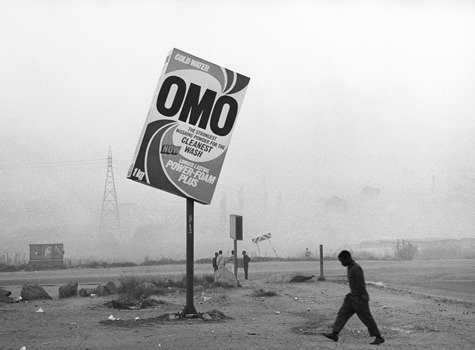Two exhibitions
dal 2/5/2012 al 28/7/2012
Segnalato da
2/5/2012
Two exhibitions
Extra City Center for Contemporary Art, Antwerp
Santu Mofokeng: 30 years of photographic essays. The Soweto of the artist's youth, his studies of quotidian life on farms and in townships, with a special focus on self-representation and family histories of the black South Africans, and pictures, which betray a concern with religious rituals and typologies of landscapes. Sharon Lockhart's installation Podworka fits as subtle social portrait; the project is both a study of a specific place and an evocation of the resourcefulness of childhood.

Sharon Lockhart
Podwórka
Podwórka
Sharon Lockhart’s film, Podwórka (2009), takes as its subject matter the courtyards of Lodz, Poland, and the children that inhabit them. A ubiquitous architectural element of the city, Lodz’ courtyards are the playgrounds of the children that live in the surrounding apartment buildings. Separated from the streets, they provide a sanctuary from the traffic and commotion of the city. Yet far from the over determined playgrounds, as we know them in the West, the courtyards are still very much urban environments. In six different courtyards throughout the city of Lodz, we see parking lots, storage units, and metal armatures become jungle gyms, sandboxes, and soccer fields in the children’s world. A series of fleeting interludes within city life, Podwórka is both a study of a specific place and an evocation of the resourcefulness of childhood. Sharon Lockhart’s installation Podwórka fits as subtle social portrait closely to Mofokeng’s work.
Sharon Lockhart was born 1964 in Norwood, Massachusetts. The American artist and filmmaker studied at the Art Center College of Design in Pasadena, and at the San Francisco Art Institute. She lives and works in Los Angeles. Her work has been shown in numerous exhibitions and screenings in America, Europe and in Japan and has won many awards. Lockhart is the recipient of fellowships from the Guggenheim Foundation, the Rockefeller Foundation and the Asian Cultural Council. Her films No and Teatro Amazonas both screened at the Berlinale, Forum of New Cinema. In February 2006, her work, Pine Flat, was shown at the Berlinale within the context of Forum expanded, the new platform for video art and installations, hosted by Forum and KW Institute for Contemporary Art.
----
Santu Mofokeng
Chasing Shadows
Thirty years of photographic essays
Curator Corinne Diserens
Santu Mofokeng is regarded as one of the most important and influential African photographers living today. His work has been presented worldwide, yet has never been subject of thorough research. Together with the artist, curator Corinne Diserens delved deep into the artist’s archives and selected more than 200 images from the last thirty years. The work presented will be complemented with extensive attention on texts written by the artist, and various documents contextualising Mofokeng’s projects. Mofokeng’s photo-essays (some of which are still on-going and have been for years) highlight a range of different issues and topics: the Soweto of the artist’s youth, his studies of quotidian life on farms and in townships, with a special focus on self-representation and family histories of the black South Africans, and pictures, which betray a concern with religious rituals and typologies of landscapes. Santu Mofokeng stretches the use of the word landscape to its fullest in order to invoke literal, colloquial, psychological, philosophical, mystical, metaphysical and metonymic meanings and applications. With Radiant Landscapes, made specially for this retrospective, Santu Mofokeng continues to explore his interest in the “invisible evils” like Apartheid and aids.
Santu Mofokeng (b1956) started taking pictures in the early ‘80s. After a short period as a street photographer and some jobs in dark rooms of newspapers, he completed his first photographic essay in 1986, entitled Train Church. Mofokeng focuses on capturing the aspects that dominate the daily life of the blacks in South Africa, like the experience of commuting and the pervasiveness of spirituality. He participated in Documenta 11 (2002) and the 52nd Venice Biennale (2007). He was a member of the Afrapix Collective (1985 – 1991), which became well known for documenting the battle against Apartheid. He also was a photography researcher for the African Studies Institute (ASI) in Johannesburg for almost ten years and received a fellowship to study at the International Center of Photography in New York. Mofokeng received a DAAD artist-in-residence in Germany and was laureate of the Prins Claus Award 2009.
Parallel to Chasing Shadows, Extra City exhibits Sharon Lockhart's subtle social portrait Podwórka, fitting closely to Mofokeng's work.
In collaboration with Vlaams-Nederlands Huis deBuren, Brussels.
Chasing Shadows is a co-production between Extra City Kunsthal, Antwerpen, Jeu de Paume, Paris, Kunsthalle Bern and Bergen Kunsthall.
With thanks to the Institut Français, Paris and Autograph ABP, London.
About Extra City Kunsthal, Antwerpen
Extra City is an autonomous centre for visual arts, acting as a platform and instigator of experimental thought and action. By means of its presentation and discursive programmes, Extra City focuses on processes of learning and sharing, consolidating the role of the art centre as a ‘safe place’ where the contemporary world can be inspected and re-imagined.
Extra City is supported by: Vlaamse Gemeenschap, Stad Antwerpen and Koning Boudewijnstichting.
Image: Santu Mofokeng, Winter in Tembisa, 1987
More information:
Carl Jacobs, Communications Manager +32 498767121 carl.jacobs@extracity.org
Footnotes to History:
Jean-François Chevrier in conversation with Santu Mofokeng and Ahlam Shibli
2 May 2012 - 8 P.M. (@ Cinema Zuid)
Opening 3 May 2012 | 7 P.M.
Extra City Kunsthal, Antwerpen
Tulpstraat 79, 2060 Antwerpen
Opening times: Wo – Su 2 – 7 pm / Thu 2 – 8 p



